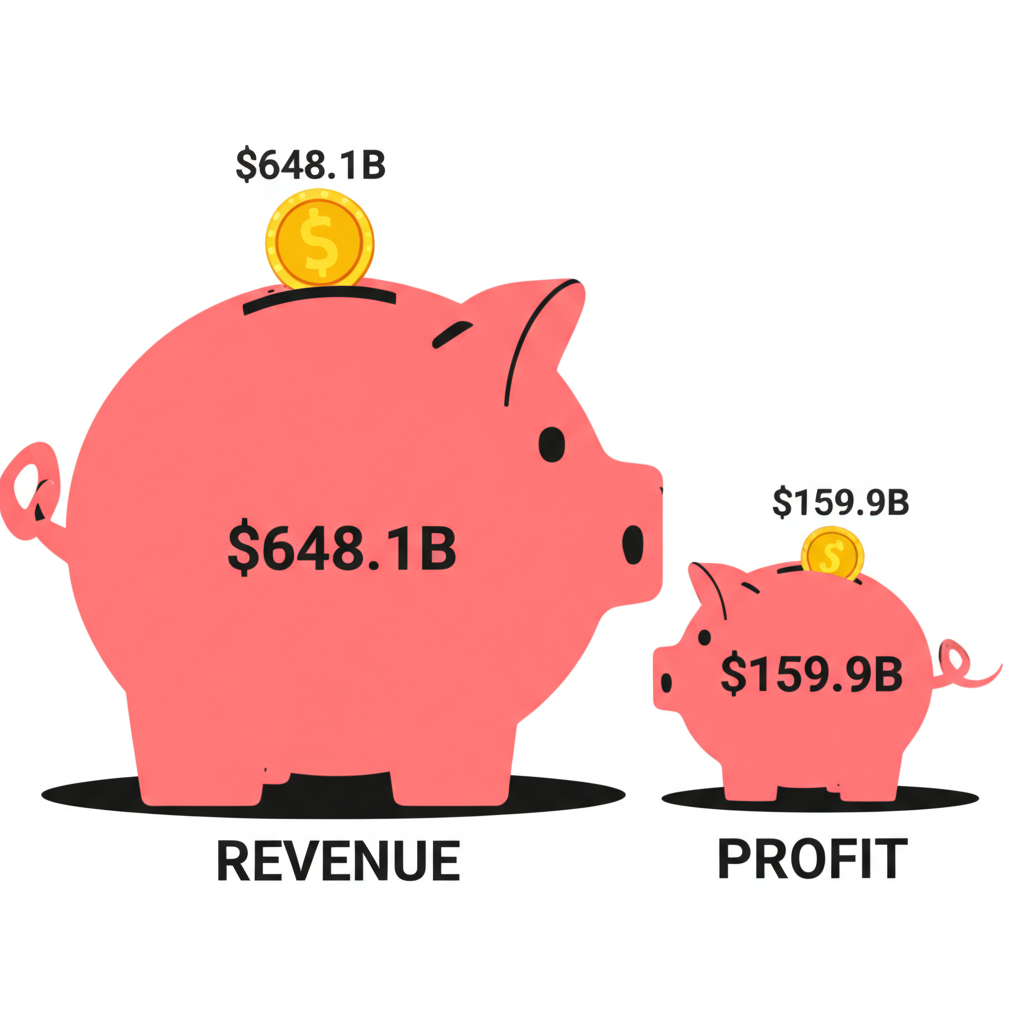Introduction: The Unparalleled Scale of Walmart

The economic influence of major global corporations often surpasses the output of entire nations, reshaping how we understand power in the modern world. At the forefront of this phenomenon stands Walmart, a retail behemoth whose annual revenue rivals—and often exceeds—the GDP of sovereign countries. This comparison, while conceptual, offers a striking perspective on the scale of corporate might in today’s interconnected economy. By examining Walmart’s financial magnitude alongside national economies, its role in the U.S. market, and its standing among global industry leaders, we gain deeper insight into how a single company can function as an economic force on par with a nation-state.
Walmart’s Financial Snapshot: Current Revenue and Global Reach

Walmart’s dominance in the global retail sector is anchored in its staggering financial performance and expansive operational footprint. In fiscal year 2024, which concluded on January 31, 2024, the company reported total revenue of approximately $648.1 billion, maintaining its position as the world’s largest company by revenue. This figure isn’t just a number—it reflects the daily movement of goods, services, and capital across continents. Walmart operates more than 10,500 stores and clubs in 19 countries, serving hundreds of millions of customers each week. With around 2.1 million employees worldwide, it ranks among the largest private employers globally. Its presence spans urban centers and rural communities alike, making it a cornerstone of both local and international economies.
Key Financial Metrics: Revenue vs. Profit

Understanding Walmart’s economic scale requires a clear distinction between revenue and profit—two metrics that reveal different aspects of corporate health. Revenue, often called the “top line,” represents the total income generated from sales before any expenses are deducted. For Walmart, this figure reached $648.1 billion in FY2024, a testament to its vast customer reach and sales volume. Profit, or the “bottom line,” reflects what remains after costs such as labor, logistics, rent, and taxes are subtracted. In the same fiscal year, Walmart’s gross profit was approximately $159.9 billion. While this is significantly lower than revenue, it still represents one of the largest profit pools in the retail sector. This gap underscores Walmart’s business model: high sales volume with relatively low margins, driven by efficiency, scale, and a relentless focus on affordability.
The “Walmart as a Country” Thought Experiment: Revenue vs. GDP

One of the most compelling ways to grasp Walmart’s economic magnitude is to consider a hypothetical: if Walmart were a country, where would its economy rank? This thought experiment, though not a direct economic comparison, vividly illustrates how corporate revenue can rival national GDP. While the analogy has limitations, it captures the imagination and forces a reevaluation of where economic power truly lies. The conversation isn’t about legal sovereignty—it’s about influence, scale, and the ability to shape markets, employment, and consumption patterns on a global level.
Understanding GDP: What It Represents for a Nation
Gross Domestic Product (GDP) measures the total value of all finished goods and services produced within a country over a specific period, usually a year. It is the primary indicator of a nation’s economic health and includes four key components: consumer spending (C), private investment (I), government expenditures (G), and net exports (exports minus imports). Unlike corporate revenue, which tracks a single entity’s sales, GDP captures the cumulative output of every business, household, and public institution within a country. It reflects not just commerce, but also infrastructure, public services, innovation, and social well-being. When we say a country’s GDP is $500 billion, we’re accounting for hospitals, schools, factories, farms, and government agencies—not just retail transactions.
The Crucial Distinction: Revenue vs. GDP
While Walmart’s revenue and a country’s GDP may appear comparable in dollar terms, they measure fundamentally different things. Walmart’s revenue is the sum of its sales—money flowing into the company from customers purchasing goods. It does not account for the full value chain behind those products, such as raw material extraction, manufacturing, or transportation. GDP, by contrast, aggregates the value added at every stage of production across an entire economy. Comparing Walmart’s revenue to a country’s GDP is like comparing the income of a single large household to the total economic activity of a city. It’s a useful metaphor for scale, but not a precise economic equivalence. Recognizing this difference prevents misinterpretation while still allowing us to appreciate the sheer size of Walmart’s operations.
Countries Whose Economies Are Smaller Than Walmart’s Revenue
Despite the conceptual nature of the comparison, the numbers speak volumes. Walmart’s FY2024 revenue of $648.1 billion exceeds the 2022 GDP of numerous countries, according to World Bank data. This places the company’s economic footprint above that of several developed and emerging economies. The list includes nations with strong industrial bases, advanced healthcare systems, and diversified markets.
| Country | 2022 GDP (Billions USD) |
| :—————— | :———————- |
| Switzerland | $807.5 |
| Poland | $688.1 |
| Belgium | $583.5 |
| Sweden | $585.9 |
| Argentina | $632.7 |
| Thailand | $536.2 |
| Nigeria | $472.6 |
| Austria | $471.0 |
| Norway | $557.7 |
| Egypt | $476.7 |
| United Arab Emirates| $507.0 |
| Ireland | $529.5 |
*Note: GDP figures are subject to change and vary slightly across different reporting agencies. The comparison uses Walmart’s FY2024 revenue against the most recently available comprehensive national GDP data.*
Even though some countries like Switzerland and Poland have higher GDPs, Walmart’s revenue still surpasses that of over 20 sovereign states. This reality underscores how multinational corporations have become central actors in the global economy, capable of generating economic activity that outpaces entire nations.
Walmart’s Impact on the US Economy
Walmart’s role in the United States extends far beyond retail. As the largest private employer in the country, it directly supports approximately 1.6 million jobs. Its stores are present in all 50 states, often serving as primary shopping destinations in communities where alternatives are limited. This widespread presence translates into significant contributions to local economies through wages, sales tax collections, and partnerships with domestic suppliers. Walmart sources a substantial portion of its products from American manufacturers, farmers, and distributors, making it a critical node in U.S. supply chains.
The company’s logistics network—one of the most advanced in the world—drives efficiency across transportation, warehousing, and inventory management. Its demand for low-cost, high-volume goods influences production standards and pricing across industries. Additionally, Walmart’s pricing strategy has long been credited with helping to keep inflation in check for essential goods, particularly in low- and middle-income households. While critics point to labor practices and market dominance, there’s no denying that Walmart plays a stabilizing role in consumer affordability and supply chain resilience. Its operations ripple across sectors, stimulating demand in everything from agriculture to digital infrastructure.
Walmart in Context: Comparing with Other Global Giants
To fully appreciate Walmart’s position, it’s essential to compare it not only to nations but also to other corporate titans. Each of these companies represents a different model of economic influence—whether through physical retail, digital platforms, or technological innovation.
Walmart vs. Amazon: A Retail Titan Showdown
The battle between Walmart and Amazon defines the evolution of modern retail. Walmart dominates through its vast network of physical stores and strong supply chain integration, while Amazon has built an empire on e-commerce, cloud computing (AWS), and digital services. For their latest fiscal periods:
| Company | Latest Annual Revenue (Billions USD) | Primary Business Model |
| :—— | :———————————– | :——————— |
| Walmart | ~$648.1 (FY2024) | Brick-and-mortar retail, growing e-commerce |
| Amazon | ~$574.8 (FY2023) | E-commerce, cloud services, digital advertising |
Amazon’s AWS division alone generated over $90 billion in revenue in 2023, providing high-margin profits that fund innovation and expansion. Walmart, in response, has aggressively invested in its digital platforms, same-day delivery, and pickup services to close the online gap. While Amazon leads in digital reach, Walmart’s hybrid model—combining physical presence with digital growth—gives it a unique advantage in omnichannel retail.
Walmart vs. Apple: Different Economic Engines
Apple represents a stark contrast to Walmart’s business model. As a technology leader, Apple generates revenue through premium-priced devices like the iPhone, Mac, and iPad, along with a rapidly expanding services segment including iCloud, Apple Music, and the App Store. In its fiscal year 2023 (ended September 2023), Apple reported revenue of approximately $383.3 billion.
| Company | Latest Annual Revenue (Billions USD) | Market Capitalization (Approx. Billions USD) | Primary Economic Driver |
| :—— | :———————————– | :——————————————- | :———————- |
| Walmart | ~$648.1 | ~$500 | High volume, low margin retail goods |
| Apple | ~$383.3 | ~$2,700 | High margin technology products and services |
Although Walmart’s revenue is nearly double that of Apple, Apple’s market capitalization is far higher, reflecting investor confidence in its profitability, brand loyalty, and innovation pipeline. This contrast highlights a key truth: economic scale isn’t just about revenue—it’s also about profit margins, growth potential, and market perception.
The Broader Implications of Corporate Economic Power
The fact that a single corporation can generate more revenue than the GDP of entire countries raises important questions about power, accountability, and governance. Companies like Walmart influence global labor standards, environmental practices, and trade policies. Their sourcing decisions can uplift or destabilize local economies in developing nations. Their pricing power can squeeze suppliers, while their employment policies affect millions of workers.
Moreover, the rise of mega-corporations challenges traditional notions of national economic sovereignty. When a company operates across borders, pays taxes in multiple jurisdictions, and negotiates with governments for incentives, it functions like a quasi-state actor. This shift demands greater transparency, corporate responsibility, and regulatory oversight. The concentration of economic power in private hands calls for a reevaluation of antitrust laws, labor rights, and global trade frameworks to ensure equitable outcomes.
Future Outlook: Walmart’s Economic Trajectory
Walmart’s future hinges on its ability to adapt to shifting consumer behaviors and technological advancements. The company is investing heavily in e-commerce, artificial intelligence, and supply chain automation to maintain its competitive edge. Its omnichannel strategy—seamlessly integrating in-store, online, and mobile experiences—positions it to capture evolving shopping habits. International expansion, particularly in markets like India and Central America, also offers growth potential.
Additionally, Walmart is expanding into financial services, healthcare, and advertising, leveraging its customer base and data insights to diversify revenue streams. These moves suggest a long-term strategy to evolve beyond traditional retail into a broader consumer services platform. While competition from Amazon, Costco, and discount retailers remains intense, Walmart’s scale, infrastructure, and focus on affordability provide a strong foundation for sustained growth. In the coming years, its revenue could approach or even exceed $700 billion, further blurring the line between corporate and national economic power.
Conclusion: A Glimpse into the Modern Global Economy
The comparison between Walmart’s revenue and national GDP is more than a statistical curiosity—it’s a window into the changing structure of global economic power. Walmart’s $648.1 billion in annual revenue, surpassing the economic output of dozens of countries, demonstrates how corporations have become central drivers of wealth, employment, and consumption. While revenue and GDP are not equivalent metrics, the analogy powerfully illustrates the scale at which modern enterprises operate.
Walmart’s influence spans continents, shapes supply chains, and affects the daily lives of millions. As a major employer, retailer, and economic engine, it exemplifies the growing role of private entities in public life. Understanding this reality is essential for policymakers, economists, and citizens alike. In an era where corporate balance sheets rival national budgets, the lines between business, governance, and society continue to blur—reshaping the 21st-century economy in profound and lasting ways.
What is Walmart’s annual revenue and how does it compare to a country’s GDP?
For fiscal year 2024, Walmart reported approximately $648.1 billion in annual revenue. This figure is larger than the GDP of a significant number of countries globally, including nations like Belgium, Sweden, and Argentina, highlighting Walmart’s immense economic scale compared to many sovereign states.
Which countries have a GDP smaller than Walmart’s yearly revenue?
Based on Walmart’s FY2024 revenue of $648.1 billion, numerous countries had a smaller GDP in 2022. Examples include Belgium ($583.5B), Sweden ($585.9B), Argentina ($632.7B), Thailand ($536.2B), and many others.
What is the main difference between a company’s revenue and a country’s Gross Domestic Product (GDP)?
Revenue is the total sales generated by a single company, representing its gross income from selling goods or services. GDP, on the other hand, is the total monetary value of all finished goods and services produced within an entire country’s borders over a specific period, encompassing the economic output of all entities (businesses, individuals, government) within that nation.
How much does Walmart contribute to the US GDP?
While a precise direct contribution to US GDP is complex to calculate, Walmart’s massive retail sales represent a significant portion of total US retail activity. As the largest private employer in the US with 1.6 million associates, and a critical player in supply chains, its operations have a substantial indirect impact on the US GDP through employment, wages, supplier demand, and economic activity across various sectors.
Is Walmart richer or larger than Amazon or Apple in economic terms?
In terms of annual revenue, Walmart ($648.1B in FY2024) is currently larger than both Amazon (~$574.8B in FY2023) and Apple (~$383.3B in FY2023). However, “richer” or “larger” can also refer to market capitalization or profitability. Apple, for example, often has a significantly higher market capitalization due to its high-margin technology products and services, despite lower revenue.
What factors contribute to Walmart’s immense economic scale?
Walmart’s immense economic scale is driven by its vast global network of over 10,500 stores, its strategy of offering everyday low prices, efficient supply chain management, a massive customer base, and its extensive workforce of over 2.1 million associates worldwide. Its growing e-commerce presence also significantly contributes to its revenue.
How has Walmart’s economic size changed over the years?
Walmart has consistently grown its revenue over the decades, evolving from a regional discounter to the world’s largest retailer. Its economic size has expanded through organic growth, international expansion, and strategic investments in e-commerce and logistics, adapting to changing retail landscapes and consumer demands.
Why is comparing a company’s revenue to a country’s GDP a popular but imperfect analogy?
It’s popular because it dramatically illustrates the sheer scale of global corporations. However, it’s imperfect because revenue is a company’s sales, while GDP measures the total economic output of an entire country, including all sectors, government spending, and investments. They are fundamentally different metrics, making it an analogy for scale rather than a direct economic equivalency.
What are the implications of a single corporation having an economy comparable to sovereign nations?
The implications include significant influence over global supply chains, labor markets, and even policy decisions. Such corporate power raises questions about market competition, corporate social responsibility, and the balance of power between private entities and national governments, shaping socio-economic and political landscapes.
What is Walmart’s gross profit and how does it relate to its overall economic impact?
For fiscal year 2024, Walmart’s gross profit was approximately $159.9 billion. Gross profit (revenue minus cost of goods sold) indicates the profitability of its core sales operations before operating expenses. While revenue highlights its market dominance, gross profit is crucial for assessing its financial health and capacity to invest, innovate, and contribute to the economy through further spending and job creation.

留言